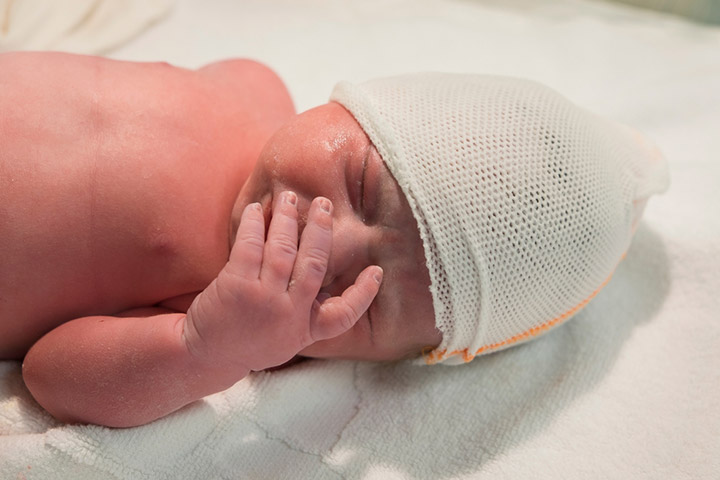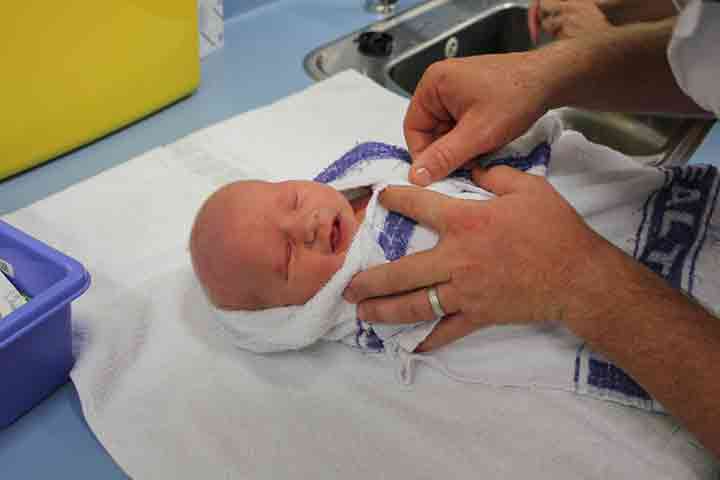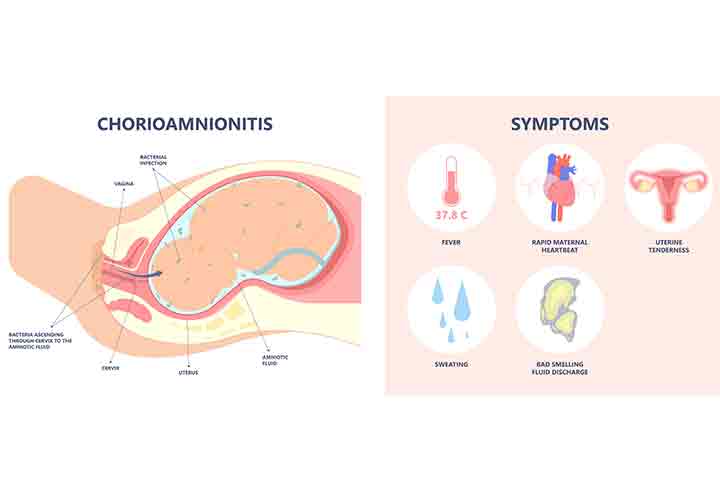Vernix caseosa, often known as vernix, is a white, waxy, creamy, or cheesy material that coats the skin of newborns. Vernix comprises the sebaceous gland and periderm cells (which cover the developing skin cells) that are shed around the 21st week of pregnancy. It acts as a fetal membrane by protecting the fetus during development as well as after birth.
Vernix may not be present on the skin of extremely premature newborns or those with very low birth weight. Further, babies born between 32 and 37 weeks of pregnancy may have more vernix than full-term neonates.
Read this article to learn about the benefits and risks of leaving vernix caseosa on a baby’s skin after delivery.
Purpose Of The Vernix Caseosa
Babies can benefit from vernix caseosa during and after pregnancy. These benefits include the following (1).
- Antimicrobial properties of vernix caseosa help the baby avoid infections that they may contract through the skin during and after delivery
- Waterproofs the fetal skin from the fluid in the womb
- Lubricates the birth canal to reduce friction during vaginal delivery
- Regulates body temperature of newborns
- Moisturizes the skin and prevents dryness and cracking
- Enhances the healing of skin wounds, if any, at birth
- Provides the newborn’s skin with antioxidant properties
Besides these benefits, vernix also has certain clinical significance. It may help doctors diagnose uterine rupture,amniotic fluidiXThe clear liquid surrounding the fetus in the womb for its protection and healthy growth. embolism, and determine the exposure of drugs in pregnant women.
Vernix caseosa is a natural protector of a baby’s skin. Allowing it to remain on the baby’s skin for a longer time, that is, delaying the first bath, may reduce the need for various protective skincare products, such as moisturizers and other protective creams for newborns.
How Long Should The Vernix Stay On A Baby’s Skin?
WHO recommends leaving the vernix intact on the skin after birth. The beneficial effects of vernix are only obtained if allowed to stay on the baby’s skin for a few hours after birth.
Recent evidence suggests that wiping off vernix for hygiene purposes, drying, or stimulating the respiratory effects may not be necessary for all babies.
Should You Delay Your Baby’s First Bath?
Delaying the first bath may help the baby reap all the benefits of vernix caseosa (2). There is no recommended time to give a bath to obtain complete benefits. However, delaying the first bath for a few hours could be beneficial.
Some mothers may not give baths to their baby for a few days to a week after birth. It is not necessary to delay bathing for several days. It is essential to remove amniotic fluid and blood from babies’ skin for hygiene purposes. You may ask the hospital staff to gently clean the baby, leaving some of the vernix on their skin. You may massage the vernix into the baby’s skin for a few days after birth.
Delaying the first bath may not be ideal for babies born with meconium- (first stool) contaminated amniotic fluid from the amniotic sac or with the risk of contracting infections from the birth canal. You may discuss with the healthcare provider to know the best time and method to bathe your baby.
Risks of Leaving Vernix On A Baby’s Skin After Birth
Leaving vernix on a newborn’s skin may not pose any risk in most cases. Babies with meconium staining or a history of chorioamnionitis may have an increased risk of developing bacterial overgrowth if the vernix is left on the skin for several hours. In some cases, leaving vernix may increase the risk of the baby contracting maternal infections, such as hepatitis and HIV.
Excess vernix on the baby’s skin may result in neonatal aspiration syndromeiXA condition where the baby breathes in its stool and amniotic fluid shortly after or during birth.. In rare cases, vernix caseosa may lead to granulomaiXA swollen cluster of white blood cells or other tissues that can be seen in the head, lungs, skin, or other body parts.and peritonitis, fetal heart infection in babies born through cesarean sections (1). The risk may vary depending on the existing health conditions, so you may take the appropriate decision according to the risks and benefits of leaving vernix on the baby’s skin.
Vernix caseosa is a naturally protective layer on a newborn’s skin. Usually, immediate bathing is not required for all babies, and if there are no such factors to delay the first bath, you may wait several hours to let your baby benefit from the vernix and soak its moisture. However, you must discuss it in detail with a healthcare professional to know about all the risks and benefits of leaving the vernix caseosa on your baby’s skin for a longer period.
Key Pointers
- Vernix caseosa has natural antimicrobial and antioxidant properties to protect a baby’s skin.
- You can delay the baby’s first bath as keeping the vernix intact on the baby’s skin after delivery is recommended.
- Too much vernix on the baby’s skin might induce newborn aspiration syndrome.













